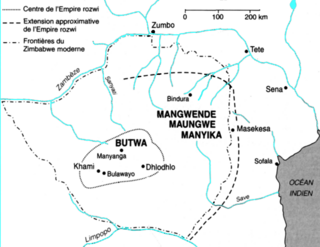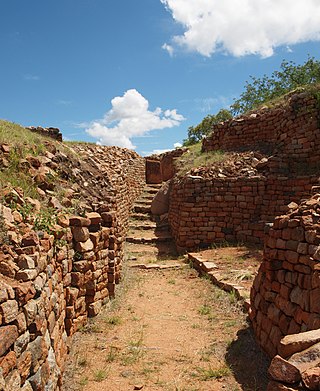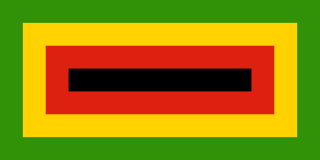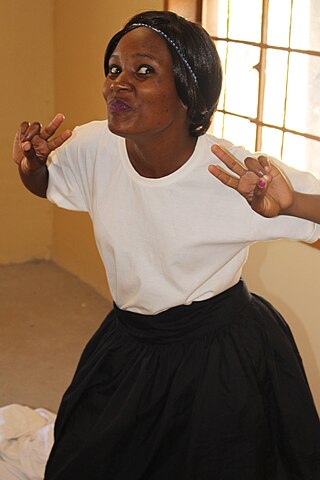Related Research Articles
Until roughly 2,000 years ago, what would become Zimbabwe was populated by ancestors of the San people. Bantu inhabitants of the region arrived and developed ceramic production in the area. A series of trading empires emerged, including the Kingdom of Mapungubwe and Kingdom of Zimbabwe. In the 1880s, the British South Africa Company began its activities in the region, leading to the colonial era in Southern Rhodesia.

The Kingdom of Mutapa – sometimes referred to as the Mutapa Empire, Mwenemutapa, – was an African kingdom in Zimbabwe, which expanded to what is now modern-day Mozambique.

Matabeleland South is a province in southwestern Zimbabwe. With a population of 683,893 as of the 2012 Zimbabwean census, it is the country's least populous province. After Matabeleland North, it is Zimbabwe's second-least densely populated province. Matabeleland South was established in 1974, when the original Matabeleland Province was divided into two provinces, the other being Matabeleland North. The province is divided into six districts. Gwanda is the capital, and Beitbridge is the province's largest town. The name "Matabeleland" is derived from Ndebele, the province's largest ethnic group.

The Rozvi Empire (1684–1866) was a Shona state established on the Zimbabwean Plateau by Changamire Dombo. The term "Rozvi" refers to their legacy as a warrior nation, taken from the Shona term kurozva, "to plunder". They became the most powerful fighting force in the whole of Zimbabwe.

The Matobo National Park forms the core of the Matobo or Matopos Hills, an area of granite kopjes and wooded valleys commencing some 35 kilometres (22 mi) south of Bulawayo, southern Zimbabwe. The hills were formed over 2 billion years ago with granite being forced to the surface; it has eroded to produce smooth "whaleback dwalas" and broken kopjes, strewn with boulders and interspersed with thickets of vegetation. Matopo/Matob was named by the Lozwi, who are the ancestors of Kalanga. A different tradition states that the first King, Mzilikazi Khumalo when told by the local residents that the great granite domes were called madombo he replied, possible half jest, "We will call them matobo" - an IsiNdebele play on 'Bald heads'.

Khami is a ruined city located 22 kilometres (14 mi) west of Bulawayo, in Zimbabwe. It was once the capital of the Kingdom of Butua of the Torwa dynasty. It is now a national monument and became a UNESCO World Heritage Site in 1986.
The Lobedu or Balobedu(also known as the BaLozwi or Bathobolo) are a southern African ethnic group that speak a Northern Sotho dialect. Their area is called Bolobedu. The name "balobedu" means "the mineral miners," lobela or go loba, - to mine. Their ancestors were part of the great Mapungubwe early civilization. They have their own kingdom, the Balobedu Kingdom, within the Limpopo Province of South Africa with a female ruler, the Rain Queen Modjadji.

The Shona people are a Bantu ethnic group native to Southern Africa, primarily living in Zimbabwe where they form the majority of the population, as well as Mozambique, South Africa, and a worldwide diaspora. There are five major Shona language/dialect clusters: Karanga, Zezuru, Korekore, Manyika, and Ndau.
The Northern Ndebele people are a Nguni ethnic group native to Southern Africa. Significant populations of native speakers of the Northen Ndebele language (siNdebele) are found in Zimbabwe. There is another Northern Ndebele group found in the Limpopo province of the republic of South Africa which is not related to those in Zimbabwe but this Northern Ndebele ethnic group is related to the Southern Ndebele ethnic group through being the descendants of same ancestral kings named Musi kaMhlanga and Ndebele KaMabhudu. The Northern Ndebele people of South Africa are concentrated in the towns of Polokwane, Zebediela, Mokopane and Hamanskraal.

Zimbabwe African National Liberation Army (ZANLA) was the military wing of the Zimbabwe African National Union (ZANU), a militant African nationalist organisation that participated in the Rhodesian Bush War against white minority rule of Rhodesia.

Nehanda Charwe Nyakasikana also known as Mbuya Nehanda was a svikiro, or spirit medium of the Zezuru Shona people. She was a medium of Nehanda, a female Shona mhondoro. As one of the spiritual leaders of the Shona, she was one of the leaders of a revolt, the Chimurenga, against the British South Africa Company's colonisation of what is now Zimbabwe led by Cecil John Rhodes in 1889. She was a Hera of the HwataShava Mufakose Dynasty. She and her ally Sekuru Kaguvi were eventually captured and executed by the company on charges of murder. She has been commemorated by Zimbabweans by statues, songs, novels, and poems, and the names of streets and hospitals. The legacy of the medium continued to be linked to the theme of resistance, particularly the guerrilla war that began in 1972. Her name became of increasing importance to the nationalist movements in Zimbabwe.

Zennyo Ryūō is a rain-god dragon in Japanese mythology. According to Japanese Buddhist tradition, the priest Kūkai made Zennyo Ryūō appear in 824 AD during a famous rainmaking contest at the Kyoto Imperial Palace.

The Second Matabele War, also known as the Matabeleland Rebellion or part of what is now known in Zimbabwe as the First Chimurenga, was fought between 1896 and 1897 in the region later known as Southern Rhodesia, now modern-day Zimbabwe. It pitted the British South Africa Company against the Matabele people, which led to conflict with the Shona people in the rest of Southern Rhodesia.
The pre-colonial history of Zimbabwe lasted until the British government granted colonial status to Southern Rhodesia in 1923.

The Kalanga or BaKalanga are a southern Bantu ethnic group mainly inhabiting Matebeleland in Zimbabwe, northern Botswana, and the Limpopo Province in South Africa.
Bishop Samuel Mutendi (c.1880-1976) was the founder of the Zimbabwean based Zion Christian Church (Z.C.C), which under his leadership grew to a membership of more than 250,000, and is believed to have grown three or four times larger today and one of the largest religious organizations in the country. As the religious leader responsible for the popularization of Zionist Christianity into Zimbabwe, he is arguably the most influential religious personality in the country's history.
Mwari also known as Musikavanhu, Musiki, Tenzi and Ishe, is the Supreme Creator deity according to Shona traditional religion. It is believed that Mwari is the author of all things and all life and all is in him. The majority of this deity's followers are concentrated in Mozambique, South Africa, and Zimbabwe. Mwari is an omnipotent being, who rules over spirits and is the Supreme God of the religion.
The M'Bona Cult is a system of religious beliefs and rituals which is currently restricted to the most southerly parts of Malawi, but which probably extended more widely, both in other parts of Malawi and adjacent parts of Mozambique. The cult is found mainly among the local Mang'anja people and its former extent reflected that people's wider past distribution. It aims to secure abundant rains at the appropriate season through the making of propitiatory gifts at cult shrines, and includes rainmaking rituals in the event of drought. It has been related to a number of other territorial cults among the Maravi cluster of related African peoples which aim to secure the well-being of the people of a particular area secure from drought, floods or food shortages. The cult is believed to be a long established one, although estimates of how long it has existed are speculative, as the earliest definite record of its existence dates from 1862.
Mhande is a traditional performance practiced among the Shona people, involving music and dance. It is a vital element of the mutoro ceremony, an annual rain ritual of the Karanga.

Indigenous religion in Zimbabwe is explained in terms of the Zimbabwe ethnic groups, beliefs, norms and values, rites and rituals, ceremonies and celebrations. Indigenous religion is more carried out by living it than with its theory. Religion among the Africans is very important, it plays a vital role for the individuals, the family and the community as a whole. Bourdlillon asserts that indigenous religion is one, though there can be various manifestation just like Christianity which is one but has various denominations. Thomas Gale defined the word indigenous as to anything that is native to a particular geographical culture. Mbiti says in Zimbabwe Indigenous religion is in two classes, the Ndebele and Shona. However, Zimbabwe has a lot of minority tribes including the Tonga, Venda, Kalanga and Sothu.
References
- 1 2 3 4 5 6 7 8 Bhebhe, Sindiso (2019-10-11). "Understanding the Traditional and Contemporary Purpose of the Njelele Rainmaking Shrine through the Oral Testimonies of Local People in Matobo". Oral History Journal of South Africa. 7 (2): 13 pages–13 pages. doi: 10.25159/2663-6670/4015 . ISSN 2663-6670. S2CID 211665761.
- ↑ "Matobo Hills". UNESCO World Heritage Centre. Retrieved 2020-06-21.
- 1 2 3 4 5 6 7 8 9 10 Makuvaza, Simon (September 2008). "Why Njelele, a Rainmaking Shrine in the Matobo World Heritage Area, Zimbabwe, Has Not Been Proclaimed a National Monument". Heritage Management. 1 (2): 163–180. doi: 10.1179/hma.2008.1.2.163 . ISSN 1940-8439.
- 1 2 3 4 Makuvaza, Simon (2008). "Why Njelele, a Rainmaking Shrine in the Matobo World Heritage Area, Zimbabwe, Has Not Been Proclaimed a National Monument". Heritage Management. 1 (2): 163–180. doi: 10.1179/hma.2008.1.2.163 . S2CID 153840563 – via ResearchGate.
- 1 2 3 4 5 Chronicle, The. "Njelele not just a rain-making shrine". The Chronicle. Retrieved 2020-06-21.
- 1 2 3 Mail, The Sunday. "Does Njelele hold the keys?". The Sunday Mail. Retrieved 2020-06-21.
- 1 2 3 4 5 6 "Unpacking the mysteries of the Njelele shrine: Part One | Celebrating Being Zimbabwean" . Retrieved 2020-06-21.
- ↑ "Seeking to understand the Njelele Shrine". Bulawayo24 News. Retrieved 2020-06-21.
- 1 2 Herald, The. "Easter time: Memories of Njelele, Mabweadziva". The Herald. Retrieved 2020-06-21.
- ↑ "DECISION OF THE WORLD HERITAGE COMMITTEE: Excerpt from the Report of the 27th Session of the World Heritage Committee" (PDF).